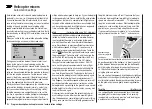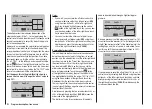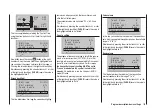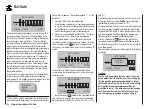
137
Program description: Telemetry menu
Telemetry
The “
Telemetry
” menu provides a means of calling up
receiver settings, and settings for any telemetry sen-
sors connected to the system, and programming them
in real-time. The transmitter is linked to the receiver via
the downlink channel which is an integral feature of the
HoTT receiver.
If Y-leads are used, a maximum of four sensors can
be connected to the Telemetry sockets of the following
receivers; this assumes that the current firmware is
loaded: GR-12S HoTT (Order No.
33505
), GR-12 HoTT
(Order No.
33506
), GR-16 (Order No.
33508
), GR-24
HoTT (Order No.
33512
) and GR-32 DUAL (Order No.
33516
).
Since the system can be updated by the user, the as-
sociated “
Telemetry
” menus can constantly be kept up-
to-date, and expanded with the introduction of additional
functions or languages in future.
Note:
If you register your product under https://www.graupner.
de/en/service/product_registration you will automatically
be informed about new updates by e-mail.
Before updating the transmitter software you should
always back up all occupied model memories to a
compatible laptop or PC in order to avoid a possible loss
of data.
As mentioned earlier, firmware can be updated and
data backed up via the transmitter’s PC socket using the
USB interface, Order No.
7168.6
, and the connecting
lead, Order No.
6466.S
, which are supplied in the set as
standard. This requires the use of a PC running Win-
dows XP, Vista or 7 as operating system.
The programs required for this and related information
can be found in the Download area for the correspond-
ing products at the website www.graupner.de. We
always recommend that you load the latest firmware into
your equipment, to ensure that your system is constantly
kept up-to-date.
Important information:
These instructions cover the functions available at
•
the time of going to press.
As mentioned in the sections entitled “Binding mul-
•
tiple receivers” on pages 80 and 88, it is possible to
bind more than one receiver per model.
However, in
subsequent operations only the receiver which
was bound last is able to make a telemetry con-
nection to the transmitter.
On the other hand, this
also means that only the last bound receiver can be
addressed using the Telemetry menu. You may there-
fore need to change the binding sequence before you
can enter settings which relate to a particular receiv-
er.
When setting up the radio control system, please
•
ensure at all times that the transmitter aerial is
an adequate distance from the receiver aerials.
A safe distance is about one metre. If you ne-
glect this, you risk interference with the downlink
channel, and consequent malfunctions.
Since the transmitter and receiver only exchange te-
•
lemetry data after each fourth data packet, data
transmission inevitably requires a certain amount of
time, which means that there will be some delay in
responding to button-presses and set-up changes.
This does not constitute an error.
Changes to model and sensor programming must
•
only be carried out when the model is on the ground.
Do not make any alterations unless the motor is
switched off and the flight battery is disconnected.
If you ignore this, unwanted effects of programming
changes cannot be excluded.
For example, if you accidentally initiate an active ser-
vo test at the receiver, the model could crash and
cause personal injury or property damage. Please
see the Safety Notes on pages 4 … 7 of this manual
and the various individual instructions.
All settings which you enter using the “
•
Telemetry
”
menu, such as Fail-Safe, servo direction, servo trav-
el, mixer and curve settings etc., are stored exclu-
sively in the receiver, and are therefore carried over
if you install the receiver in a different model. For this
reason we strongly recommend that you re-initial-
ise your HoTT receiver if you wish to use it in another
model; see “Reset” on page 44 and 45.
We therefore recommend that you program directions
•
of servo rotation, servo travel, mixer and curve set-
tings using only the
mx-16
-specific standard men-
us “
Servo settings
” (page 92), “
Free mixers
” (page
127) and “
D/R Expo
” (pages 102 and 104). If you ig-
nore this, the settings may overlap and interfere with
each other; in the most favourable case this can re-
sult in confusion when operating the model, and in
the least favourable case it could cause problems.
The channel-mapping function of the
•
mx-16
HoTT’s integral “
Telemetry
” menu can be used to
share out control functions between multiple receiv-
ers in any way, or even to assign the same control
function to several receiver outputs; for example, you
may wish to operate each aileron with two servos in-
stead of just one, etc.
Once again we strongly re-
commend that you act as cautiously as possible
when carrying out the programming.
Summary of Contents for mx-12 Hott
Page 1: ...Programming Manual 33116 mx 16 HoTT 3 en mx 16...
Page 35: ...35 For your notes...
Page 49: ...49 For your notes...
Page 55: ...55 For your notes...
Page 59: ...59 For your notes...
Page 63: ...63 For your notes...
Page 69: ...69 For your notes...
Page 91: ...91 For your notes...
Page 101: ...101 For your notes...
Page 123: ...123 For your notes...
Page 181: ...181 For your notes...
Page 193: ...193 For your notes...
















































